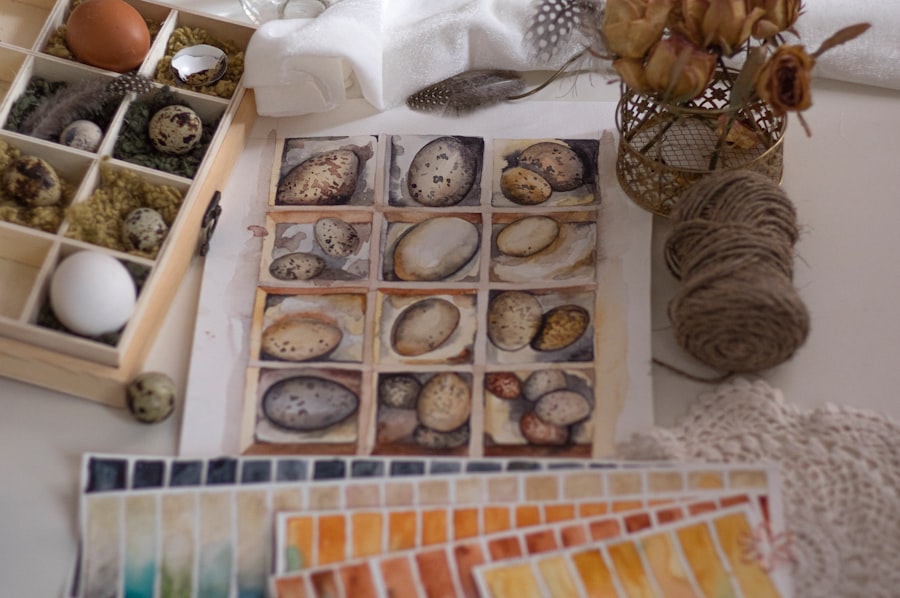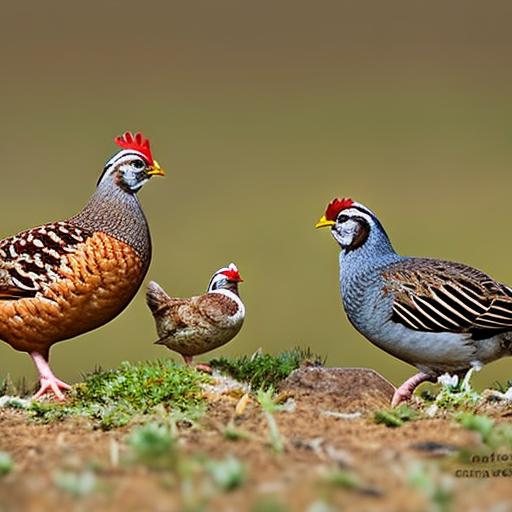Keeping quail and chickens together can be a rewarding experience for poultry enthusiasts. Both quail and chickens are popular choices for backyard farming due to their small size, low maintenance, and ability to provide fresh eggs and meat. While they have some similarities in terms of care and housing, there are also key differences that need to be considered when keeping them together. Understanding these differences and taking the necessary steps to accommodate both species can lead to a harmonious and productive environment for both quail and chickens.
Quail are known for their small size and delicate nature, while chickens are larger and more robust. Quail are ground-dwelling birds that prefer to stay close to the ground, while chickens are more inclined to perch and explore higher areas. These differences in behavior and space requirements need to be taken into account when planning a shared living space for quail and chickens. By understanding the unique needs of each species, poultry keepers can create an environment that meets the needs of both quail and chickens, promoting their well-being and productivity.
Key Takeaways
- Keeping quail and chickens together can be beneficial for both species
- Quail require less space than chickens and have different behavioral patterns
- Factors to consider when determining distance include size, temperament, and housing setup
- Recommended distance between quail and chickens is at least 2-3 feet to prevent stress and aggression
- Providing separate feeding and watering stations can help maintain a harmonious environment
Understanding the differences in space requirements for quail and chickens
When it comes to space requirements, quail and chickens have different needs that must be considered when keeping them together. Quail are ground-dwelling birds that prefer to have access to a larger floor space rather than vertical space. They are also more sensitive to overcrowding and can become stressed if they do not have enough room to move around freely. On the other hand, chickens are more inclined to perch and explore higher areas, so they require vertical space for roosting and nesting.
Quail typically require at least 1 square foot of floor space per bird, while chickens need around 4 square feet of space per bird in the coop. When it comes to outdoor runs, quail need a minimum of 2 square feet per bird, while chickens require at least 10 square feet per bird. These differences in space requirements mean that careful planning is necessary to ensure that both quail and chickens have enough space to thrive in a shared environment. Providing adequate space for both species will help reduce stress, aggression, and competition for resources, leading to a more harmonious living arrangement.
Factors to consider when determining the distance between quail and chickens
When determining the distance between quail and chickens in a shared space, there are several factors that need to be taken into consideration. One important factor is the size of the living area and whether it can accommodate the space requirements of both quail and chickens. It’s essential to ensure that there is enough room for both species to move around comfortably without feeling crowded or stressed.
Another factor to consider is the behavior of quail and chickens. Quail are ground-dwelling birds that prefer to stay close to the ground, while chickens are more inclined to perch and explore higher areas. This means that the living space should be designed to cater to the natural behaviors of both species, providing ground-level areas for quail and elevated spaces for chickens to roost and nest.
Additionally, the distance between quail and chickens should take into account their social dynamics. Both quail and chickens have their own pecking orders and hierarchies within their flocks. It’s important to ensure that there is enough distance between the two species to prevent aggression, competition for resources, and potential injury. By considering these factors, poultry keepers can create a living space that meets the needs of both quail and chickens, promoting a harmonious coexistence.
Recommended distance between quail and chickens in a shared space
The recommended distance between quail and chickens in a shared space will depend on several factors, including the size of the living area, the number of birds, and the behavior of each species. As a general guideline, it’s recommended to provide separate living quarters for quail and chickens if possible. This can help reduce the risk of aggression, competition for resources, and potential injury between the two species.
If separate living quarters are not feasible, providing adequate distance between quail and chickens within the same living space is crucial. For example, if using a shared outdoor run, it’s recommended to divide the area into separate sections for quail and chickens using wire mesh or fencing. This can help prevent direct contact between the two species while still allowing them to share the same outdoor space.
In terms of indoor coops or housing, providing separate areas for roosting and nesting can help minimize potential conflicts between quail and chickens. If using a single coop for both species, ensuring that there are enough perches and ground-level areas for both quail and chickens can help promote a harmonious living environment. By providing adequate distance between quail and chickens in a shared space, poultry keepers can help reduce stress, aggression, and competition for resources, promoting the well-being of both species.
Tips for maintaining a harmonious environment for quail and chickens
Maintaining a harmonious environment for quail and chickens in a shared living space requires careful planning and consideration of their unique needs. One important tip is to provide separate areas for feeding and watering to prevent competition between quail and chickens. This can help ensure that both species have access to food and water without feeling stressed or threatened by the presence of the other species.
Another tip is to provide plenty of hiding spots and shelters within the living area for both quail and chickens. This can help reduce stress and aggression by giving each bird a place to retreat if they feel threatened or overwhelmed. Providing hiding spots can also help promote a sense of security for both quail and chickens, leading to a more relaxed and harmonious living environment.
Additionally, monitoring the behavior of quail and chickens regularly can help identify any potential conflicts or issues within the shared living space. By observing their interactions, poultry keepers can make adjustments as needed to ensure that both species are thriving in their environment. Providing enrichment activities such as dust baths, perches, and toys can also help keep both quail and chickens stimulated and content in a shared living space.
Monitoring and adjusting the distance between quail and chickens as needed

Monitoring the distance between quail and chickens in a shared living space is crucial for ensuring their well-being and harmony. Regular observation of their behavior can help identify any potential conflicts or issues that may arise. If aggression or competition for resources is observed between quail and chickens, adjustments may need to be made to the living space to promote a more harmonious environment.
One way to adjust the distance between quail and chickens is by providing additional hiding spots or shelters within the living area. This can give each bird a place to retreat if they feel threatened or overwhelmed by the presence of the other species. Adding more hiding spots can help reduce stress and aggression, promoting a more relaxed living environment for both quail and chickens.
Another way to adjust the distance between quail and chickens is by providing separate feeding and watering areas within the living space. This can help prevent competition between the two species, ensuring that both quail and chickens have access to food and water without feeling stressed or threatened by the presence of the other species. By monitoring their behavior regularly and making adjustments as needed, poultry keepers can promote a harmonious environment for both quail and chickens in a shared living space.
Ensuring the well-being of both quail and chickens in a shared environment
In conclusion, keeping quail and chickens together in a shared living space can be a rewarding experience for poultry enthusiasts. Understanding the differences in space requirements, behavior, and social dynamics between quail and chickens is crucial for creating a harmonious environment that meets the needs of both species. By providing adequate distance between quail and chickens, monitoring their behavior regularly, and making adjustments as needed, poultry keepers can ensure the well-being of both quail and chickens in a shared environment.
Maintaining a harmonious environment for quail and chickens requires careful planning, observation, and consideration of their unique needs. By providing separate areas for feeding and watering, plenty of hiding spots, shelters, and enrichment activities within the living space, poultry keepers can help reduce stress, aggression, and competition for resources between quail and chickens. Regular monitoring of their behavior can help identify any potential conflicts or issues within the shared living space, allowing adjustments to be made as needed to promote a more relaxed environment for both species.
Overall, creating a harmonious environment for quail and chickens in a shared living space requires attention to detail, patience, and a deep understanding of their individual needs. By taking these factors into consideration, poultry keepers can create an environment where both quail and chickens can thrive, providing fresh eggs, meat, and enjoyment for their caretakers.
When it comes to raising quail and chickens, it’s important to consider the distance between their living spaces. According to a related article on PoultryWizard, the placement of your chicken coop can have a significant impact on the well-being of your flock. To learn more about where to put your chicken coop and how it can affect the distance between your quail and chickens, check out this informative article. Additionally, understanding the best type of coop for your chickens, as discussed in this article, can also help you make informed decisions about keeping your quail and chickens at an appropriate distance from each other.
FAQs
What is the recommended distance to keep quail and chickens apart?
The recommended distance to keep quail and chickens apart is at least 50 feet. This distance helps to minimize the risk of disease transmission between the two species.
Why is it important to keep quail and chickens apart?
It is important to keep quail and chickens apart to reduce the risk of disease transmission. Quail and chickens can carry different diseases that can be harmful to each other if they come into close contact.
What are the potential risks of keeping quail and chickens together?
Keeping quail and chickens together can increase the risk of disease transmission between the two species. This can lead to illness and potential loss of the birds.
Can quail and chickens be housed in the same coop if they are kept apart?
It is not recommended to house quail and chickens in the same coop, even if they are kept apart. Separate housing and living areas are ideal to minimize the risk of disease transmission.
Are there any other considerations for keeping quail and chickens apart?
In addition to keeping quail and chickens at least 50 feet apart, it is important to practice good biosecurity measures, such as regular cleaning and disinfection of equipment and housing, to further reduce the risk of disease transmission.
Meet Walter, the feathered-friend fanatic of Florida! Nestled in the sunshine state, Walter struts through life with his feathered companions, clucking his way to happiness. With a coop that’s fancier than a five-star hotel, he’s the Don Juan of the chicken world. When he’s not teaching his hens to do the cha-cha, you’ll find him in a heated debate with his prized rooster, Sir Clucks-a-Lot. Walter’s poultry passion is no yolk; he’s the sunny-side-up guy you never knew you needed in your flock of friends!







